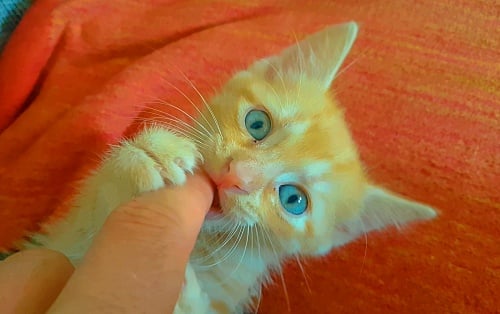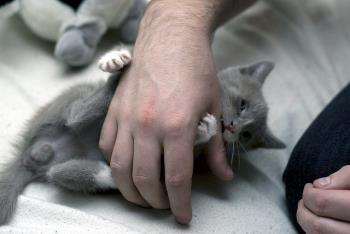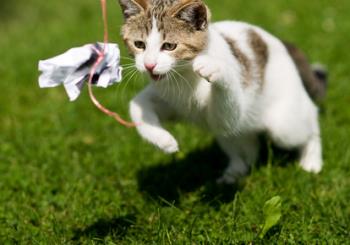Does your cat act aggressively and even bites you as you play with them? Many of our pet parents ask “Why do cats bite when they play?”. It’s common for kittens and young cats to bite when playing, but if you don’t stop the behavior early, it may continue into adulthood. At that time, the cute little love bite of an adorable little kitten can become harsh and painful.
In this article, you’ll learn why cats bite when they play and 6 ways to stop your cat from aggressive behavior during play sessions and other activities. You will also find out the best way to play with your cat without being scratched.

Table of Contents
- Why do cats bite when they play?
- How to stop a cat from biting during play
- 6 ways to stop cat bites when playing
- 4 more ways to reduce cat bites while playing
Disclaimer: This article focuses on solving a specific feline aggression type which is known as play aggression in cats. This is often confused with offensive or defensive aggression due to fear and territorial issues. You can learn more about the causes of human-directed aggression in cats, but we advise you to consult a professional animal behaviorist and your veterinarian when dealing with cat aggression.
Why do cats bite when they play?
Play aggression (commonly referred to as predatory aggression) is a natural cat behavior because playing is hunting. Hunting is a method to survive for your cat in a natural environment. However, as natural as it may be, problems arise if the cat exhibits play aggression towards humans;
- If they scratch and bites your hands too hard.
- If your cat becomes overly aggressive towards other pets.
- If your cat’s prey instincts keep them awake at night.
To stop a cat from biting, it’s necessary to understand the natural impulses behind this behavior. So, why do cat bite when they play with you? Short answer is because your cat thinks your body parts are prey.
You’ve probably noticed that when you use a toy or scratch your fingers under a sheet, your cat is aroused by this almost immediately. We mentioned before that prey instinct is almost uncontrollable for the cat. Your cat sees a moving object; no time to identify whether it’s a mouse or something else your cat jumps right on it.
How to not stop your cat from biting during play
Do not punish your cat for being aggressive! Why?
Punishment will not work.
It may make the situation worse and turn your cat’s play aggression into fear aggression. This is where your cat takes to attacking you because he or she is afraid of you.
Play aggression is not your cat’s fault.
Remember how we said that play behavior is instinctive? Your cat sees a target and can’t help but try to catch it. And yes, punishment is cruel, but that’s not even the main thing.

Kitten hand-wrestling teaches the wrong lesson.
While this is one of the most popular things to do when playing with a kitten, it unintentionally teaches the wrong thing. As cute as it is, it reinforces aggression in later life.
Do not use your fingers and hands for playing. Also, do not hand-wrestle with your kitten and do not rub his belly, even if it’s so inviting. This is a paradox. People complain about their cats biting their fingers, but they use fingers as toys for their cat. You can’t expect your cat not to bite your fingers (or ankles, or feet) if you use them for playing now and then.
Stopping now, of course, won’t make your cat less aggressive towards parts of your body, but it is a necessary step to begin the change. We strongly recommend to our patients owners, especially new cat owners to never use fingers for play. Forget that you ever used them and your cat might forget too.
6 ways to stop cat bites when playing
1. Guide your cat’s predatory energy towards playing
Your cat bites when playing because it’s natural for a cat to want to attack moving objects. It’s the reason why your cat plays. They learned this predatory behavior when young by playing. If your cat’s desire gets satisfied through playing, they will never have a reason to attack you. There are two playing methods: interactive play, where a cat plays with a toy controlled by his owner (but not his owner’s fingers), and solo play, where a cat enjoys toys on their own. The first one is more powerful to stop your cat from biting your fingers; however, it requires your involvement, and it’s best to provide both.
2. Get a few interactive toys
Use them every day and enjoy several 5- to 15-minute play sessions with your cat. Of course, the more often you play with your cat the better. Check here for tips to find more time to play with your cat. Let your cat be aggressive towards the toy; keep their focus away from your fingers, arms, and feet. Remember, if you move the toy, YOU are in control, and your cat will focus his attention on you. You will see a significant decrease in your cat’s general aggression and restlessness after just a few days, but don’t stop there. Regular activities are the key to stop your cat from biting you.
3. Provide solo play opportunities for your cat
As a cat owner, you can’t be around all day and night to do nothing else but have play sessions with your cat. While interactive play is important as a learning and communication tool, it may not be enough for your cat to expend all their energy.
Choices for solo toys are pretty broad, starting from bouncy balls and mice on wires, and ending with puzzle feeders and electronic toys. The choice is up to you, but we’d recommend you have at least one treat dispenser ball. That is a small ball filled with cat food kibble. As your cat plays with it, pieces drop out one by one. Provide at least one of your cat’s meals this way. It stimulates your cat to hunt for food and it will keep them interested in playing.

4. Teach your cat to play the right way
And teach yourself the right way to play, too. Don’t bounce the toy back and forth rapidly, making your cat’s eyes spin; avoid from wiggling it and do not dangle it in your cat’s face. Instead, use lateral movements and generally drag the toy away, not towards your cat. Use varying speeds; let your cat catch and chew the toy now and then. Keep the toy a safe distance from your feet, fingers, or other body parts your cat likes to attack, and make sure his attention is on the toy.
5. Stop playing once your cat attacks you.
The best method is to play with your cat in such a way that they never gets to the point of attacking. But if they do, abruptly end the play session and leave the room. You are free to re-enter after a few minutes, but do not resume playing with your cat until he is settled down. Most cats love playing, and the thing is to teach your cat that if he bites when playing, the playing stops . That is, it is okay for your cat to be aggressive, but this aggression must be directed towards toys.
6. Learn to predict when your cat will attack you.
Put on your thinking cap to figure out when it’s about to happen. It’s easy to observe your cats body language when they are playing normally. Now compare that to when it changes. You’ll notice that their energy suddenly rises and they lash out with an attack. Did you notice what was going on just prior to the attack? Was your cat growling before that? Was your cat’s tail or skin twitching, or was he or she hissing before an attack? Keep this information in your head when you interact with your cat and make sure you give yourself time to act BEFORE their aggression begins.
4 more ways to reduce cat bites while playing
Option 1: Reduce the intensity of playing. For example, if you are petting your cat, slow down the petting or stop it completely. See here for more information about cat biting during petting. It’s okay to play aggressively with your cat. But let the toy be the target of your cats love bite instead of your fingers.
Option 2: Try to focus your cat’s attention towards the toy. If you are playing with an interactive toy, dangle it away from you. If you are entering a room, throw a solo toy in a different direction to attract your cat’s attention.
Option 3: Step away. If you have time to step away, do it. Taking a few steps aside may reduce your cat’s interest in your feet or fingers. Consider leaving the room if you still have time. If you don’t, your last option is…
Option 4: Startle your cat if the attack has already begun. Loudly clap your hands or make a hissing sound. It should stop him for a moment, giving you a chance to leave. Don’t turn this into a more extended session of yelling or scolding your cat. Remember, don’t punish; startle your cat to stop your his dangerous activity and then leave.
Your cat will not stop biting overnight, though you will probably see rapid improvements after you begin to implement these strategies.
Remember: it’s okay for your cat to be aggressive during play. Cats are hunters, and they see playing as equal to hunting. The behavior that is not okay is when your cat bites you while playing. Instead of your fingers they should bite the toy. This is what you are trying to achieve. With patience and consistency, you can stop your cat from biting you while playing and other activities. You will be happier (and less injured) and your pet will be happier too. And a happy pet is what we all want right?
If you are having other behavior problems with your cat, check this list here.
